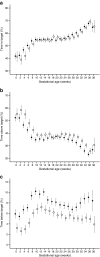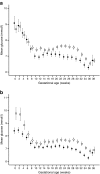Continuous glucose monitoring in pregnant women with type 1 diabetes: an observational cohort study of 186 pregnancies
- PMID: 30904938
- PMCID: PMC6560021
- DOI: 10.1007/s00125-019-4850-0
Continuous glucose monitoring in pregnant women with type 1 diabetes: an observational cohort study of 186 pregnancies
Abstract
Aims/hypothesis: The aim of this study was to analyse patterns of continuous glucose monitoring (CGM) data for associations with large for gestational age (LGA) infants and an adverse neonatal composite outcome (NCO) in pregnancies in women with type 1 diabetes.
Methods: This was an observational cohort study of 186 pregnant women with type 1 diabetes in Sweden. The interstitial glucose readings from 92 real-time (rt) CGM and 94 intermittently viewed (i) CGM devices were used to calculate mean glucose, SD, CV%, time spent in target range (3.5-7.8 mmol/l), mean amplitude of glucose excursions and also high and low blood glucose indices (HBGI and LBGI, respectively). Electronic records provided information on maternal demographics and neonatal outcomes. Associations between CGM indices and neonatal outcomes were analysed by stepwise logistic regression analysis adjusted for confounders.
Results: The number of infants born LGA was similar in rtCGM and iCGM users (52% vs 53%). In the combined group, elevated mean glucose levels in the second and the third trimester were significantly associated with LGA (OR 1.53, 95% CI 1.12, 2.08, and OR 1.57, 95% CI 1.12, 2.19, respectively). Furthermore, a high percentage of time in target in the second and the third trimester was associated with lower risk of LGA (OR 0.96, 95% CI 0.94, 0.99 and OR 0.97, 95% CI 0.95, 1.00, respectively). The same associations were found for mean glucose and for time in target and the risk of NCO in all trimesters. SD was significantly associated with LGA in the second trimester and with NCO in the third trimester. Glucose patterns did not differ between rtCGM and iCGM users except that rtCGM users had lower LBGI and spent less time below target.
Conclusions/interpretation: Higher mean glucose levels, higher SD and less time in target range were associated with increased risk of LGA and NCO. Despite the use of CGM throughout pregnancy, the day-to-day glucose control was not optimal and the incidence of LGA remained high.
Keywords: Continuous glucose monitoring; Fetal growth; Neonatal complications; Pregnancy; Type 1 diabetes.
Figures


References
Publication types
MeSH terms
LinkOut - more resources
Full Text Sources
Medical

